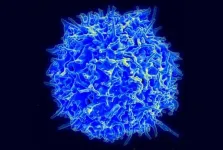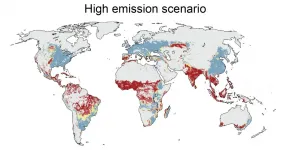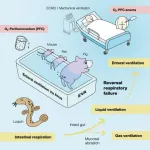(Press-News.org) May 14, 2021 - Two thirds of all pediatric spinal fractures, especially in the adolescent population, occur in motor vehicle accidents (MVAs) where seatbelts are not utilized, reports a study in Spine. The journal is published in the Lippincott portfolio by Wolters Kluwer.
"Over 60 percent of pediatric spinal fractures occur in children ages 15 to 17, coinciding with the beginning of legal driving," according to the new research by Dr. Vishal Sarwahi, MD, of Cohen Children's Medical Center, New Hyde Park, NY, and colleagues. They emphasize the need for measures to increase seatbelt usage, particularly by younger drivers, and outline the potential trauma that can be avoided through proper seatbelt use.
Seatbelts save lives... and spines
Motor vehicle accidents are the leading cause of death amongst teenagers in the United States. Many previous studies have reported rising rates of pediatric spinal injuries, especially in teens aged 15 and older. This new study confirms that MVAs, in fact, cause most spinal fractures in children and adolescents, with high rates of other injuries. Spinal fractures in young patients are also associated with a three percent mortality rate, with many deaths occurring in unrestrained drivers and passengers.
Using the American College of Surgeons' National Trauma Data Bank, Dr. Sarwahi and his colleagues studied 34,563 pediatric patients (younger than 18 years) who sustained spinal fractures between 2009 and 2014. Many of the patients had multiple spinal fractures, with a total of 45,430 fractured vertebrae.
Overall, teenagers between age 15 and 17 years accounted for about 63 percent of spinal fractures, two-thirds of which occurred in MVAs. These findings show that around the time teens get their drivers' license, drivers and passengers are at highest risk for MVA resulting in spinal fracture.
Fifty-eight percent of the injured patients were male. Pediatric spinal fractures were found to be most common in the South: 38 percent, probably due to a lack of public transport resulting in more vehicles on the road.
The study also shows the impact of seatbelt use on these devastating injuries. "Nearly two-thirds of pediatric spinal fractures sustained in MVAs occurred in children who did not use belts," Dr. Sarwahi and co-authors write. Without seatbelts, the risks of severe or multiple injuries and death are substantially increased, with a significantly increased death rate from 29.3 percent to 70.7 percent - more than doubled.
Data on seatbelt use was available for nearly 19,000 patients, with approximately two-thirds of patients (65.9 percent) unrestrained. Almost half (44.2 percent) of unrestrained patients in MVAs were teenagers. Despite a larger percentage of MVAs occurring in the South overall, the percentage of spinal fractures from MVAs for unrestrained drivers and passengers was similar across all regions of the United States; approximately two-thirds of all teenagers across all regions - Northeast, Midwest, West, South - involved in MVAs did not wear seatbelts. This demonstrates the universality of teenage risk-taking behavior and identifies at-risk groups for risk modification strategies.
When seatbelts were worn, the rate of spinal fractures was substantially lower for all drivers and passengers. Seatbelt use lowered the risk of death by more than 20 percent. For young patients in MVAs, wearing seatbelts was also associated with lower rates of multiple vertebral fractures, other types of fractures in addition to spinal fracture, and head and brain injury.
While the percentage of drivers wearing seatbelts has risen steadily over the years, adolescents and young adults remain less likely to use these lifesaving devices. Dr. Sarwahi and colleagues discuss targeted approaches using technology and media awareness campaigns to increase seatbelt use among young people, as well as studies showing the importance of societal and cultural norms related to seatbelts. The researchers conclude: "Ensuring our new, young drivers wear protective devices can greatly reduce morbidity/mortality associated with MVA and can help save lives, and spines."
INFORMATION:
Click here to read "Seatbelts Save Lives, and Spines, in Motor Vehicle Accidents: A Review of the National Trauma Data Bank in the Pediatric Population."
DOI: 10.1097/BRS.0000000000004072
About Spine
Recognized internationally as the leading journal in its field, Spine (http://www.spinejournal.com) is an international, peer-reviewed, bi-weekly periodical that considers for publication original articles in the field of spine. It is the leading subspecialty journal for the treatment of spinal disorders. Only original papers are considered for publication with the understanding that they are contributed solely to Spine. According to the latest ISI Science Citation Impact Factor, Spine is the most frequently cited spinal deformity journal among general orthopaedic journals and subspecialty titles.
About Wolters Kluwer
Wolters Kluwer (WKL) is a global leader in professional information, software solutions, and services for the clinicians, nurses, accountants, lawyers, and tax, finance, audit, risk, compliance, and regulatory sectors. We help our customers make critical decisions every day by providing expert solutions that combine deep domain knowledge with advanced technology and services.
Wolters Kluwer reported 2020 annual revenues of €4.6 billion. The group serves customers in over 180 countries, maintains operations in over 40 countries, and employs approximately 19,200 people worldwide. The company is headquartered in Alphen aan den Rijn, the Netherlands.
Wolters Kluwer provides trusted clinical technology and evidence-based solutions that engage clinicians, patients, researchers and students in effective decision-making and outcomes across healthcare. We support clinical effectiveness, learning and research, clinical surveillance and compliance, as well as data solutions. For more information about our solutions, visit https://www.wolterskluwer.com/en/health and follow us on LinkedIn and Twitter @WKHealth.
For more information, visit http://www.wolterskluwer.com, follow us on Twitter, Facebook, LinkedIn, and YouTube.
May 14, 2021 - Two years ago, the Veterans Affairs healthcare system (VA) began rolling out a new benefit, enabling Veterans to receive urgent care from a network of community providers - rather than visiting a VA emergency department or clinic. Progress toward expanding community care services for Veterans is the focus of a special supplement to the May issue of Medical Care. The journal is published in the Lippincott portfolio by Wolters Kluwer.
The urgent care benefit "provides a new way to deliver unscheduled, low-acuity acute care to Veterans," according to the ...
A team led by researchers at Weill Cornell Medicine and Children's National Hospital has developed a unique pre-clinical model that enables the study of long-term HIV infection, and the testing of new therapies aimed at curing the disease.
Ordinary mice cannot be infected with HIV, so previous HIV mouse models have used mice that carry human stem cells or CD4 T cells, a type of immune cell that can be infected with HIV. But these models tend to have limited utility because the human cells soon perceive the tissues of their mouse hosts as "foreign," ...
The question of why we dream is a divisive topic within the scientific community: it's hard to prove concretely why dreams occur and the neuroscience field is saturated with hypotheses. Inspired by techniques used to train deep neural networks, Erik Hoel (@erikphoel), a research assistant professor of neuroscience at Tufts University, argues for a new theory of dreams: the overfitted brain hypothesis. The hypothesis, described May 14 in a review in the journal Patterns, suggests that the strangeness of our dreams serves to help our brains better generalize our day-to-day experiences.
"There's obviously an incredible number of theories of why we dream," says Hoel. "But I wanted to bring to ...
Rodents and pigs share with certain aquatic organisms the ability to use their intestines for respiration, finds a study publishing May 14th in the journal Med. The researchers demonstrated that the delivery of oxygen gas or oxygenated liquid through the rectum provided vital rescue to two mammalian models of respiratory failure.
"Artificial respiratory support plays a vital role in the clinical management of respiratory failure due to severe illnesses such as pneumonia or acute respiratory distress syndrome," says senior study author Takanori Takebe (@TakebeLab) of the Tokyo Medical and Dental University and the Cincinnati Children's Hospital Medical Center. "Although the side effects and safety need to be thoroughly ...
Climate change is known to negatively affect agriculture and livestock, but there has been little scientific knowledge on which regions of the planet would be touched or what the biggest risks may be. New research led by Aalto University assesses just how global food production will be affected if greenhouse gas emissions are left uncut. The study is published in the prestigious journal One Earth on Friday 14 May.
'Our research shows that rapid, out-of-control growth of greenhouse gas emissions may, by the end of the century, lead to more than a third of current global food production falling into conditions in which no food is produced today - that is, out of safe climatic space,' explains Matti Kummu, professor of global water and food issues at Aalto University.
According ...
What The Study Did: Researchers analyzed changes in filled prescriptions for naloxone (medication to reverse opioid overdoses) during the COVID-19 pandemic in the United States and compared them with changes in opioid prescriptions and overall prescriptions.
Authors: Ashley L. O'Donoghue, Ph.D., of the Beth Israel Deaconess Medical Center in Boston, is the corresponding author.
To access the embargoed study: Visit our For The Media website at this link https://media.jamanetwork.com/
(doi:10.1001/jamahealthforum.2021.0393)
Editor's Note: The ...
What The Study Did: Associations of staffing and testing interventions with COVID-19 transmission in nursing homes are examined in this decision analytical modeling study.
Authors: Rebecca Kahn, Ph.D., of the Harvard T.H. Chan School of Public Health in Boston, is the corresponding author.
To access the embargoed study: Visit our For The Media website at this link https://media.jamanetwork.com/
(doi:10.1001/jamanetworkopen.2021.10071)
Editor's Note: The article includes conflict of interest and funding/support disclosures. Please see the article for additional information, including other authors, author contributions and affiliations, conflict of interest and financial disclosures, ...
What The Study Did: This is a qualitative study that evaluates a crowdsourcing open call to gather community input for engaging the university community in COVID-19 safety strategies.
Authors: Suzanne Day, Ph.D., of the University of North Carolina at Chapel Hill, is the corresponding author.
To access the embargoed study: Visit our For The Media website at this link https://media.jamanetwork.com/
(doi:10.1001/jamanetworkopen.2021.10090)
Editor's Note: This article includes funding/support disclosures. Please see the article for additional information, including other authors, author contributions and affiliations, conflict of interest and financial disclosures, and funding and support.
INFORMATION:
Media ...
What The Study Did: Researchers evaluated the compliance of hospitals with a Centers for Medicare & Medicaid Services ruling mandating that a list of charges for services, procedures and items be publicly available and in a machine-readable file.
Authors: David Hsiehchen, M.D., of the University of Texas Southwestern Medical Center in Dallas, is the corresponding author.
To access the embargoed study: Visit our For The Media website at this link https://media.jamanetwork.com/
(doi:10.1001/jamanetworkopen.2021.10109)
Editor's Note: Please see the article for additional information, ...
Tokyo, Japan - Oxygen is crucial to many forms of life. Its delivery to the organs and tissues of the body through the process of respiration is vital for most biological processes. Now, researchers at Tokyo Medical and Dental University (TMDU) have shown that oxygen can be delivered through the wall of the intestine to compensate for the reduced availability of oxygen within the body that occurs in lung diseases that cause respiratory failure.
To breathe is to live; for higher animals, respiration involves absorbing oxygen and excreting carbon dioxide at gills or in the lungs. However, some animals have evolved alternative ventilatory mechanisms: loaches, catfish, sea cucumbers and orb-weaving spiders can absorb oxygen through their hindgut to ...



